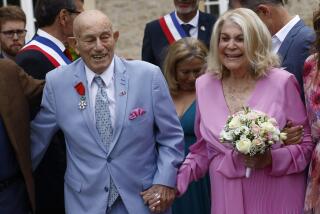The Battle Now Is With Time
INDEPENDENCE, Ohio — INDEPENDENCE, Ohio -- Every three months, the old soldiers straggle into a white clapboard veterans post south of Cleveland, taking roll of their dwindling ranks and swapping war stories. The tales told by the Ohioans of North Coast Chapter 36 of the Veterans of the Battle of the Bulge evaporate with the fleeting scent of beer and cigars, as perishable as their fading generation.
A decade ago, there were 104 men in the chapter. Now there are 64. The survivors save old logs, official minutes, rosters, raffle accounts. But few found time to preserve their World War II reminiscences. Their yarns seemed destined not to outlive them, finite as a dying language.
“Who cares about a bunch of old soldiers’ memories?” said George Tachuk, 84, a retired accountant who serves as the group’s treasurer. But after the veterans finished their Pledge of Allegiance last month, a man from the Library of Congress stood up. Tom Swope asked the old soldiers if they would recount their stories for a massive oral history project that aims to store the recollections of thousands of American veterans in the library’s Washington archives.
Swope left with nine names. “Better now than never,” said Tachuk, who has begun to write his memoirs as an Army signalman, uncertain whether his wartime legacy would find a permanent home.
The Veterans History Project is a novel exercise in oral history and a race against the clock. Conceived two years ago as an ambitious attempt to tap the collective memories of soldiers from World War I through the Persian Gulf War in 1991, the project is the most sweeping government effort to amass personal American chronicles since the Great Depression.
As a new war looms in Iraq, the library’s archivists face a pressing generational deadline. They already have amassed narratives and relics from more than 3,000 soldiers -- including 2,100 from World War II-era veterans. But they have reached only a fraction of the 4 million living Americans who served the country six decades ago and are now dying at the rate of 1,500 a day.
Despite the public fascination with military heroes that spawned “Saving Private Ryan” and a commercial explosion of books and films about the World War II generation, the veterans project has had to struggle to raise its profile. Its archivists depend on citizen volunteers to nudge veterans into looking backward. And they rely on the old soldiers themselves to vouch for the accuracy of war stories that are sometimes prone to exaggeration.
“We’re trying to be broad and populist about it,” said Ellen McCulloch-Lovell, the cultural historian who heads the project. “An infantryman or a supply clerk is as important to us as a general.”
The notion that every soldier’s story matters has energized volunteers such as Swope, a former television writer whose obsession with his father’s war has spurred him into tracking down and interviewing 120 Cleveland veterans -- more than any other of the scores of volunteer interviewers.
“These stories are like family heirlooms that nobody cared about,” he said. “It’s about time somebody found a place for them.”
There are harrowing battle tales. And there are the modest accounts of veterans who simply wanted someone to listen. Swope spent hours one morning with L.A. Biggs, a retired Teamster whose war years passed uneventfully ferrying U.S. troops across the Atlantic. When they were done, Biggs clapped him on the shoulder.
“Things happen in your life and you’re just grateful someone takes the time to put it all down,” he said.
Swope makes the rounds at Veterans Day dinners and Legionnaires’ meetings, listening for natural storytellers, their raucous laughter and boasts. But he watches, too, for the men who say nothing. He frets about wasted time and missed opportunities. Four of the men he taped have died. A fifth veteran died last week, two days before a planned interview session. Swope learned the news from the man’s widow.
“Some of these guys are so frail I worry they’ll make it through the interview,” Swope said.
The narratives he sends in are transcribed for historians, researchers, veterans’ families, “anyone who wants to know what it was like to live through the war,” McCulloch-Lovell said. Although much of the material will be made available only in its Washington archives, the library has laid plans to put a broad sampling on its Web site.
Hundreds of recordings, transcripts and mounds of wartime correspondence and memorabilia have stacked up in shelves inside the project’s archives near the Capitol. There are photo albums thick with yellowing snapshots of GIs on liberty in Paris and searching for survivors of Nazi death camps.
There are the family chronicles sent by Marion Gurfein to her husband, Joseph, an Army colonel and engineer who served in war zones during World War II, Korea and Vietnam. Drawn to resemble a small-town journal, the quaint “Goofein Press” brought small-bore dispatches from home.
Another row of folders contains 1,261 neatly bundled letters exchanged between a Brooklyn GI and his young wife. Now 82, Jerry Brenner, a former government economic analyst who saw action in Germany as a radio operator for the 740th Field Artillery Battalion, figured his intimate correspondence with his wife, Norma, might provide “a sense of how important letters from home were to a young soldier. There’s no heroic stuff in there. But when I heard what the library was after, I figured they’d do more good there than packed away in my closet.”
The war’s approaching 50th anniversary in the early 1990s had stimulated a sharpened interest in the use of oral histories, even as veterans such as Brenner were wondering what to do with their mementos and their memories. The Army and other services already owned extensive battle narratives. Academic archives had sprouted at Rutgers University in New Jersey and in New Orleans, where the late historian Stephen E. Ambrose built a research bank of 2,400 accounts of D-day, Iwo Jima and other key battles.
Historian Douglas Brinkley, who heads Ambrose’s Eisenhower Center museum, wonders whether “we’re reaching a saturation point on World War II narratives.” He admires the project’s “grand sweep,” but questions the value of limitless scouring for stories. Only the most revelatory have any real historical significance, he said.
“You don’t need interviews from 500 company clerks,” he said.
But under the project’s broad mandate, every story counts, McCulloch-Lovell said. Still, time might be a limiting factor. Some oral historians said they have been told the search is expected to last no more than five years.
The project is also constrained by its $250,000 annual budget. A $3-million grant from AARP helped hire archivists, but there is no money for professional interviewers. Unlike the Depression-era Federal Writers Project, which hired 300 unemployed writers to fan out across the country in the mid-1930s to hunt down American oral narratives, the veterans project has turned to novice volunteers from high schools, retirement groups and church clubs.
“There’s tremendous value not only for the people being interviewed, but for the interviewers,” said Mary Marshall Clark, who heads Columbia University’s Oral History Research Office. Some novices have been given training by professionals. But most are armed only with an instruction kit and enthusiasm.
In Warwick, R.I., Mayor Scott Avedsian persuaded high schools to urge students to interview veterans. More than 100 have been selected since the fall, he said. Senior citizens in the San Francisco Bay Area suburb of Walnut Creek asked around their Leisure World retirement community for World War II veterans. They turned up 33 GIs.
“I’ve got 65 more names on my list and they’re still calling,” marveled Ed Berman, 73, who heads the Leisure World team.
They are all outpaced by the tireless Swope, whose war fascination has led to a Sunday morning public-service radio show on a suburban Cleveland station, spinning old swing records along with his taped interviews.
Swope’s obsession was triggered by his father’s spare accounts of his war years. Clarence Swope was an infantryman sent to the front lines in eastern France in late 1944, captured by German troops and sent to a POW camp.
Swope pestered his father to open up about his experiences, but the old man fended him off, relenting only several years before he died.
“He went up to a little cabin he owned in the Pennsylvania hills, got a few highballs in him, played some old 78s, and started talking,” Swope said. “It all sort of tumbled out, amazing stuff. It got me wondering how many other guys like him have bottled up these great stories.”
On one recent snow-swirled morning, Swope sat down at his kitchen table with Steve Hegedus, 78, a retired firefighter who served with the 11th Airborne Division as a paratrooper when American forces retook the Philippines from the Japanese. Hegedus had phoned after reading about Swope’s work in a suburban Cleveland newspaper. He had regaled his family with his old war tales, but was eager to leave “something permanent.” Moments after stamping the snow off his shoes, Hegedus was reeling back in time.
He recounted a mad dash “at Olympian speed” to catch a troop train in Utah and avoid being imprisoned on an AWOL charge. He described the soaring thrill of his first parachute jump. He told of the day he sat down on a mustard gas specimen during training in North Carolina, winding up in a military hospital where a chemical weapons specialist from Washington “inspected my rear end.”
But Hegedus seemed wary of reliving his most intense memories.
“I don’t get nightmares,” the old paratrooper insisted. But Swope and other project interviewers have discovered that few World War II veterans are eager to rush back into the thick of battle. Many dwell on lighter antics.
“I think it’s a defense mechanism,” Swope said. “It’s still painful after all this time.” If he senses a darker story, “it’s worth testing at least a little bit.” But he does not pry. “It’s tough to see them break down.”
Hegedus remained dry-eyed as he described U.S. troops cut down by Japanese machine-gun fire, enemy soldiers dispatched point blank by pistol shots to the head, an eyebrow found on a rifle butt after a savage round of hand-to-hand combat. After two hours, Hegedus heaved a loud sigh.
“Whoo! Some of these things I haven’t thought about in 57 years,” he said.
His memories were bound for the archives, along with a sheaf of release forms and biographical questions required of all the storytellers. But in an era when almost nothing is taken at face value, everything sent in to the oral history project is taken on faith.
The archivists read over the transcripts and examine the mementos. But they do not check for accuracy or verify service records.
“With the World War II vets, our first priority is persuading them to send in their interviews and submissions as fast as we can get them,” McCulloch-Lovell said. “We don’t want to do anything to slow that process.”
Aware that the historical value of the collection could be undermined by fraudulent accounts, McCulloch-Lovell said she raised concerns two years ago with military historians who helped her set up the project soon after it was shepherded through Congress by its main sponsor, Rep. Ron Kind (D-Wis.). They told her “it was extremely rare for veterans to lie about their service records,” she said.
But fraud is a real threat, said retired Marine Col. Mitchell Paige, a decorated 84-year-old La Quinta resident who was awarded the Medal of Honor for his service on the Pacific island of Guadalcanal.
“I’d have everything checked out,” said Paige, who has spent decades defrocking World War II-era medal impostors. As they age, there are fewer impostors to bust. But over the last year, Paige said, he and FBI agent Thomas Cottone have investigated 40 obituary notices for fraudulent Medal of Honor recipients.
“People just want to be heroes, I guess,” he said.
McCulloch-Lovell has no plans to change procedures, preferring to “see evidence of a problem first before I put a brake on submissions.”
In the 10 years since they banded together, the Ohioans of North Coast Chapter 36 have also taken their tales on faith. “If someone was a phony,” Tachuk said, “don’t you think we’d know it?”
There are more pressing matters these days, hearing disabilities and heart ailments, insomnia and cancer. Tachuk notices how hard it is for them to sit down, then get back up again. One recent afternoon, he attended funerals for two old soldiers. An aged bugler blew taps. “It breaks your heart to hear that,” he said.
He brightened among old buddies, growing quiet as familiar tales flew. A signalman with the 75th Division, Tachuk spent the Battle of the Bulge at headquarters, well behind the fraying American lines where German troops made their last advance. He brought home no tales of glory.
As one old vet rose to make a florid tribute to Gen. George S. Patton, “the savior of the war,” Tachuk nodded silently, as if an old big-band tune was playing.
He knows the stories by heart now, as if they were his own. “I feel like I’ve been with the artillery, the infantry, the interrogators,” he said. “Some of these stories sound so real it feels like you were right there with ‘em.” His own tales are tamer. But now there is a place for them too.
More to Read
Sign up for Essential California
The most important California stories and recommendations in your inbox every morning.
You may occasionally receive promotional content from the Los Angeles Times.










